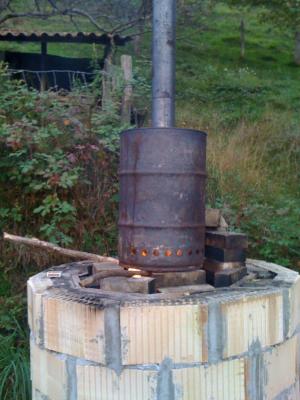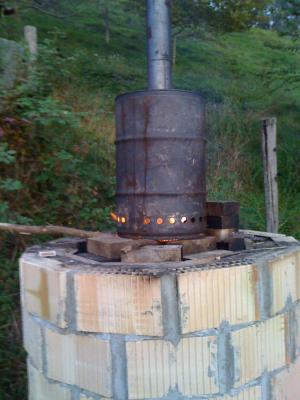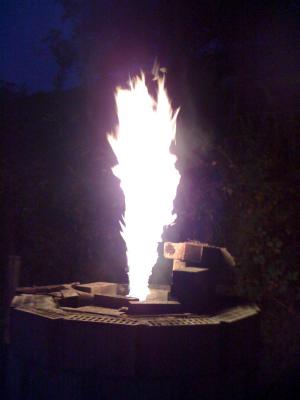Design for flaring offgasses
- Log in to post comments
Nando M. Breiter
The CarbonZero Project
0736 shows my kiln, filled with wood to char. Nevermind that it looks a little blacked ( ... aborted previous attempt)
0737 shows the new cover I cut this afternoon, from 3mm sheet steel
0738 shows some firebricks arranged on top of the cover, it's weighted to help seal it. The fact that it's not screwed or clamped down allows for a simple pressure relief valve that won't get clogged with tar.
0739 shows the planned positioning of an afterburner, centered on the cover plate
0740 shows the stove pipe chimney on top of the afterburner.
The retort is surrounded with firebrick and heated from below, using a bit of firewood. It's an air tight process, rather than a restricted oxygen flow process. This allows close control of the pyrolysis temperature.
So here's a question for those with experience in these things. I plan to drill a hole in the center of the cover to vent the offgases. I could simply drill a 10mm hole, let them flow up into my primitive afterburner, and see how well it works. Perhaps there is a better way. I could imagine using a proper burner, which I know next to nothing about designing, and heating water, stones, air, driving a cyclone engine, etc.
I've had trouble with the lid (on the barrel) warping when it heats up. I wound up cutting 3 different lids trying different thicknesses of sheet metal. Today I managed with the original and lots of weight on one corner. I'm continually surprised by the challenges you encounter doing this.
The lid I wound up using had a 6 cm hole it it, so I put 2 firebricks over the top of it and left a slit about 1 cm wide. Since the wood was already dry, I had the kiln up to 300 C in about 30 minutes time. That was encouraging. But since I was having trouble with the lid, I unfortunately couldn't collect data regarding wood weights and regular temperature measurements.
Once I had a steady stream of smoke coming from the center hole, I placed my afterburner over it and lit the flare using a paraffin fire starting cube. That worked for about 5 minutes or so. When the paraffin was exhausted, the flare went out. So I used another paraffin cube to get it going again, and I added 2 small diameter sticks of wood through gaps under the afterburner to maintain the flame, as you can see in 0741 & 0743. That worked. The flare didn't go out again.
0742 shows how clean the flame was at this point, no visible smoke.
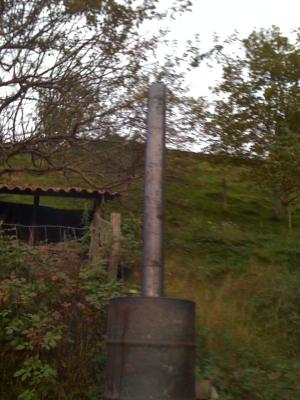
After a while, the unit began to produce a greater flow of gas, and it seems there wasn't enough oxygen available because the gas coming out the stack began to get a little smokey. I took a few large diameter pipes, what I had at hand, and placed them to try and deliver more air. That didn't help to clear the smoke. I also tried to ease the afterburner higher to see if a larger gap underneath would provide more air, and it tipped over.
See 0746 and 0747. The flare makes an easily audible "roar". :-) I'm not sure at what point the flare no longer needed a support flame, but here it was self maintaining.
An interesting result with this burn is that the retort at the top measuring point only reached 360 C. My guess is that this is because I was releasing heat with the offgases more freely from the center hole, which was approximately 6 cm2 in surface area. Interesting thought that the retort temperature might be partially regulated by the size of this hole.
As you can see in 0744, an afterburner designed from thin metal sheet isn't going to be durable. My thought of the moment is that the best would be if the offgases could be flared in a firebrick enclosure. That implies piping them, as a firebrick enclosure would be impractical above the kiln. If the offgases condense, they will block the pipework, so that implies insulation and/or using a bit of the heat generated to keep the pipes warm.
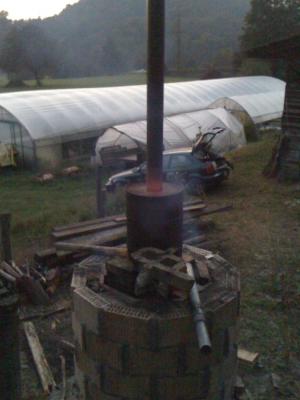
Perhaps I could also just increase the height of the existing firebrick enclosure. Ideally, the smoke from the wood fire underneath would also be flared. I'd like to keep the design simple so it could be replicated widely in a variety of contexts using cheap, available materials and simple manufacturing techniques.
I also need to tackle the problem of a retort cover that won't warp with the heat it is subjected to. I tried going thinner but that didn't help. The idea is to be able to swap barrels in and out of the enclosure quickly and use the same durable cover with whatever fittings are needed for the offgas / flare system.
Any suggestions are welcome ...
NandoAdidas footwear | Nike Little Posite Pro USA CZ2520-600 Release Date - SBD

